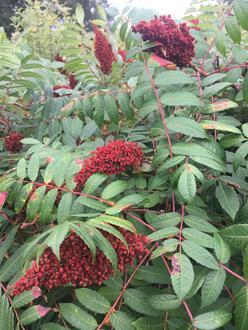Smooth Sumac (Rhus glabra L.)
↑Summary
A thicket-forming, drought-tolerant shrub or small tree, native to a wide range across North America.
↑Range - Expand
| Legend | Color |
| Native | |
| Native or Not Present | |
| Native or Expanded | |
| Expanded or Not Present |
This tentative map is based on our own research. It may have limited data on Canada and/or Mexico, and there is some subjectivity in our assignment of plants as introduced vs. expanded. Read more in this blog post.
Although this plant occurs somewhere in each of these regions, it may only occur in a small part of some or all of them.
↑Description & Identification
A thicket-forming shrub to 20 feet tall, often much shorter, especially on drier sites. Branches, twigs, petioles, and central stems of leaves are hairless, often reddish, with waxy whitish coating. Leaves opposite and pinnately compound, with serrated margins.
↑Similar Plants
↑Habitat
Prefers sunny conditions on slightly acidic to neutral soils. Found in a wide range of habitats. In the humid east, limited to more disturbed and open habitats, including open woodlands, dry rocky hillsides, and in numerous anthropogenic habitats including abandoned fields, along railroads and roadsides, and in waste areas. Often found in edge habitats where it benefits from increased light. In the east, found on sites too harsh for other sumacs, including talus slopes and shale barrens.
Intolerant of shade or poorly-drained sites.
In the central US, found in prairies and savannas, where it forms dense thickets.
In the most arid portions of the west, found on moister, more sheltered sites in canyons and ravines.
In eastern North America, mostly limited to early-successional habitats, but in the northwest, it can form a stable climax community in scrublands and grasslands. Can persist similarly in prairies and savannas where fire has been suppressed.
↑Faunal Associations
This species is seen as having a high wildlife value. The flowers attract a wide range of pollinators, and numerous insects also eat the various parts of the plant.
The fruits are eaten by animals, primarily in winter when other foods are scarce. Both songbirds and upland game birds eat the fruits. Deer and rabbits browse the stems and foliage.
This plant, however, tends to have low value to domestic livestock. As such it often persists or increases in overgrazed pastures.
Especially in the west and central US where plant growth is scarcer, smooth sumac is important as cover due to the density of thickets it forms.
↑Uses
Occasionally planted as an ornamental, where it is valued for its attractive form, bold fall color, and small maximum height. Especially in the southwest, it is valuable in xeriscaping because of its drought tolerance.
Occasionally planted to control erosion on dry slopes. Used in roadside plantings, where it is favored for its small maximum height, reducing the need for pruning. Also sometimes planted in cold climates as a living snow fence, or as a shelterbelt species.
Used to reclaim and revegetate damaged land, including strip mines, abandoned landfills, and road cuts. Rootstock has good survival even when transplanted into extreme conditions.
The fruit can be used to make a beverage.
↑Related Plants
Closely related to staghorn sumac (Rhus typhina), and able to hybridize with it, forming Rhus x Borealis. Hybrids are especially common in the upper midwest, Wisconsin east to Michigan, but have also been recorded on scattered sites in the east from Maine south to North Carolina.
10 other Rhus species are native to North America. However, over most of this species range, the only overlapping species are aromatica, typhina, and copallinum.
↑Links & External Resources
• Smooth Sumac | Fire Effects Information System (FEIS) (About This Site)
• Rhus glabra (Smooth Sumac) | Illinois Wildflowers (About This Site)
• Rhus glabra (Smooth Sumac) | USDA PLANTS Database (About This Site)
• Rhus glabra | Go Botany (About This Site)
• Rhus glabra (Smooth Sumac) | Missouri Botanical Garden Plant Finder (About This Site)
• Smooth Sumac | Virginia Tech Dendrology Factsheets (About This Site)
• Rhus glabra | Biota of North America Project (BONAP) (About This Site)
• Rhus glabra | NatureServe Explorer (About This Site)
• Rhus glabra | Missouri Plants (About This Site)
• Smooth Sumac | Maryland Biodiversity Project (About This Site)
• Rhus glabra L. (Smooth Sumac) | Digital Atlas of the Virginia Flora (About This Site)










